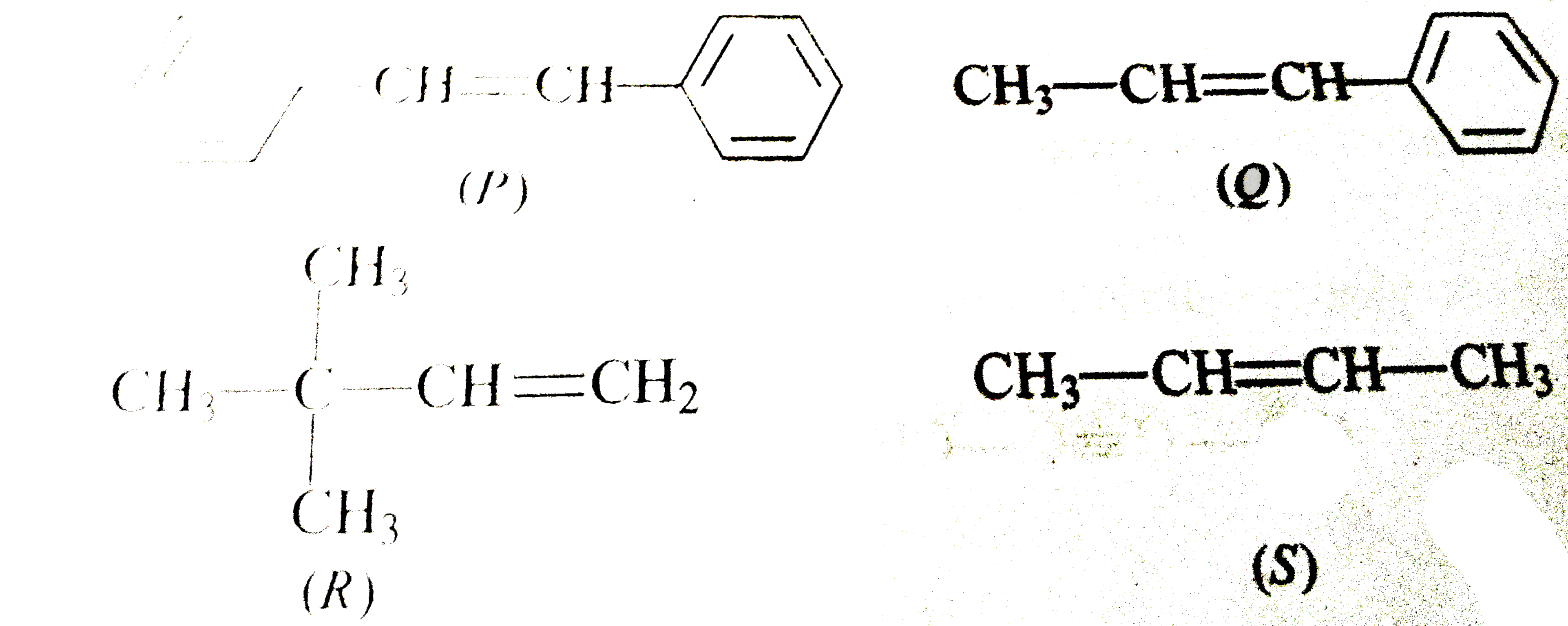The relative rate of catalytic hydrogenation of the following alkenes is :

I>II>III>IV
III>II>I>IV
IV>T>II>III
IV>I>II=III
The correct Answer is:c
Step by step video, text & image solution for The relative rate of catalytic hydrogenation of the following alkenes is : by Chemistry experts to help you in doubts & scoring excellent marks in Class 12 exams.
Updated on:21/07/2023Topper's Solved these Questions
- HYDROCARBONSBOOK - DISHA PUBLICATIONCHAPTER - HYDROCARBONSEXERCISE - EXERCISE -2 CONCEPT APPLICATOR
29 Videos
- HYDROCARBONSBOOK - DISHA PUBLICATIONCHAPTER - HYDROCARBONSEXERCISE - EXERCISE -2 CONCEPT APPLICATOR
29 Videos
- HALOALKANES AND HALOARENES BOOK - DISHA PUBLICATIONCHAPTER - HALOALKANES AND HALOARENES EXERCISE - Exercise -2 : Concept Applicator
28 Videos
- HYDROGENBOOK - DISHA PUBLICATIONCHAPTER - HYDROGENEXERCISE - Exercise - 2 : Concept Applicator
30 Videos
Similar Questions
Catalytic hydrogenation involves addition of hydrogen to a C=Cor−C≡C− bond in presence of a metal catalyst such as Ni, Pt, Pd, etc. These are called heterogeneous catalysts. Both H2 and alkene/alkyne get adsorbed on the surface of the metal , and syn-addition of hydrogen atoms takes place. The relative rates of hydrogenation follows the order:
−C≡C−>C=C>C=O>C6H6
If sodium or lithium in liquid ammonia is used, anti-addition of H-atoms occurs across −C≡C−bond. These reducing agents can also be used to reduce double bonds of benzene rings and conjugated dienes but not of isolated dienes.
The catalytic hydrogenation of which of the following alkenes is most exothermic ?
View SolutionThe relative rates of hydrogenation is in the order of
View Solution
Knowledge Check
Hydrogenation of alkenes and alkynes takes place in presence of certain catalysts. In Sabatier Senderen's reaction, the addition of hydrogen takes place I presence of Raney nickel catalyst. Platininm and palladium can also be used as catalyst and used in finley divided state. Experimentally, it is observed that less crowded alkenes adsorb H2 with faster rate. Controlled hydrogenation of alkyne H2 with faster rate. Controlled hydrogenation of alkyne in presence of Lindlar's catalyst yields cis product i.e., 'cis' alkene. Thus, in presence of Lindlar's catalyst 'syn' addition takes place. The relative rate of hydrogenation follows the order:

Non-terminal alkynes are reduced in presence of Na or Li metal dissolved in liquid ammonia. In this reaction, anti-addition of hydrogen results into the trans-product.
Answer the following questions:
The relative rate of catalytic hydrogenation of following alkenes is:
 AII gt III gt IV gt IBI gt IV gt III gt IICIII gt IV gt I gt IIDII gt IV gt I gt III
AII gt III gt IV gt IBI gt IV gt III gt IICIII gt IV gt I gt IIDII gt IV gt I gt IIIHydrogenation of alkenes and alkynes takes place in presence of certain catalysts. In Sabatier Senderen's reaction, the addition of hydrogen takes place I presence of Raney nickel catalyst. Platininm and palladium can also be used as catalyst and used in finley divided state. Experimentally, it is observed that less crowded alkenes adsorb H2 with faster rate. Controlled hydrogenation of alkyne H2 with faster rate. Controlled hydrogenation of alkyne in presence of Lindlar's catalyst yields cis product i.e., 'cis' alkene. Thus, in presence of Lindlar's catalyst 'syn' addition takes place. The relative rate of hydrogenation follows the order:

Non-terminal alkynes are reduced in presence of Na or Li metal dissolved in liquid ammonia. In this reaction, anti-addition of hydrogen results into the trans-product.
Answer the following questions:
The relative rate of catalytic hydrogenation of following alkenes is:
 AIIgtIIIgtIVgtIBIgtIVgtIIIgtIICIIIgtIVgtIgtIIDIIgtIVgtIgtIII
AIIgtIIIgtIVgtIBIgtIVgtIIIgtIICIIIgtIVgtIgtIIDIIgtIVgtIgtIIIRates of hydrohalogenation of the following alkene are:
 AP>Q>R>SBQ>P>R>SCQ>P>S>RDP>Q>S>R
AP>Q>R>SBQ>P>R>SCQ>P>S>RDP>Q>S>R
